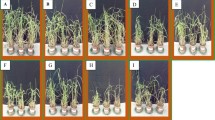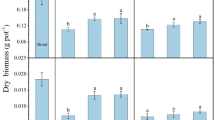Abstract
A field study of cadmium phytoremediation by Ocimum gratissimum L. and the potential enhancement by two cadmium-resistant bacteria, Ralstonia sp. TISTR 2219 and Arthrobacter sp. TISTR 2220, were explored in a cadmium-polluted agricultural area. The results demonstrated the ability of one of the bacterial strains to promote cadmium accumulation in O. gratissimum L. planted in soil with cadmium concentrations till 65.2 mg kg−1. After transplantation in contaminated soil for 2 months, soil inoculation with Arthrobacter sp. enhanced cadmium accumulation in the roots, above-ground tissues, and whole plant of O. gratissimum L. by 1.2-fold, 1.4-fold, and 1.1-fold, respectively, compared with the untreated control. The presence of Arthrobacter sp. in soil facilitated cadmium phytoremediation in O. gratissimum L. similar to that of an EDTA application. Seeds of O. gratissimum L. grown in polluted soil contained undetectable to negligible concentrations of cadmium. Significant increases in the bioconcentration and translocation factors of O. gratissimum L. were observed in Arthrobacter sp.-inoculated plants at only 2 months post-transplant compared with the uninoculated control. The highest percentage of cadmium removal was found in soil used to cultivate EDTA-treated O. gratissimum L., followed by an Arthrobacter sp.-inoculated plant. Our findings suggest that the synergistic use of Arthrobacter sp. with O. gratissimum L., an essential oil-producing crop, could be a feasible economic and environmental option for the reclamation of cadmium-polluted areas.



Similar content being viewed by others
References
Ali H, Khan E, Sajad MA (2013) Phytoremediation of heavy metals—concepts and applications. Chemosphere 91:869–881
Belimov AA, Hontzeas N, Safronova VI, Demchinskaya SV, Piluzza G, Bullitta S, Glick BR (2005) Cadmium-tolerant plant growth-promoting bacteria associated with the roots of Indian mustard (Brassica juncea L. Czern.). Soil Biol Biochem 37:241–250
Benavides MP, Gallego SM, Tomaro ML (2005) Cadmium toxicity in plant. Braz J Plant Physiol 17:21–34
Boruvka L, Kozak J, Kristoufkova S (1997) Heavy metal accumulation in plants grown in heavily polluted soils. Folia Microbiol 42:524–526
Branquinho C, Serrano HC, Pinto MJ, Martins-Loução MA (2007) Revisiting the plant hyperaccumulation criteria to rare plants and earth abundant elements. Environ Pollut 146:437–443
Chen JH, Czaika D, Lion L, Shuler M, Ghiorse W (1995) Trace metal mobilization in soil by bacterial polymer. Environ Health Perspect 103:52–58
Chiu KK, Ye ZH, Wong MH (2006) Growth of Vetiveria zizanioides and Phragmities australis on Pb/Zn and Cu mine tailings amended with manure compost and sewage sludge: a greenhouse study. Bioresour Technol 97:158–170
Crommentuijn T, Doornekamp A, Van Gestel CAM (1997) Bioavailability and ecological effects of cadmium on Folsomia candida (Willem) in an artificial soil substrate as influenced by pH and organic matter. Appl Soil Ecol 5:261–271
Dell’ Amico E, Cavalca L, Andreoni V (2008) Improvement of Brassica napus growth under cadmium stress by cadmium-resistant rhizobacteria. Soil Biol Biochem 40:74–84
Department of Environmental Quality Promotion (2011) Mineral mining bonanza or bust: green line. Ministry of Natural Resources and Environment, Bangkok
Evangelou MWH, Ebel M, Schaeffer A (2007) Chelate assisted phytoextraction of heavy metals from soil: effect, mechanism, toxicity, and fate of chelating agents. Chemosphere 68:989–1003
Gao Y, Miao C, Wang Y, Xia J, Zhou P (2012) Metal-resistant microorganisms and metal chelators synergistically enhance the phytoremediation efficiency of Solanum nigrum L. in Cd- and Pb-contaminated soil. Environ Technol 33:1383–1389
Hardy JK, O’Keeffe DH (1985) Cadmium uptake by the water hyacinth: effects of root mass, solution volume, complexers and other metal ions. Chemosphere 14:417–426
He LY, Chen ZJ, Ren GD, Zhang YF, Qian M, Sheng XF (2009) Increased cadmium and lead uptake of a cadmium hyperaccumulator tomato by cadmium-resistant bacteria. Ecotoxicol Environ Saf 72:1343–1348
Jensen-Spaulding A, Shuler ML, Lion LW (2004) Mobilization of adsorbed copper and lead from naturally aged soil by bacterial extracellular polymers. Water Res 38:1121–1128
Jiang XJ, Luo YM, Zhao QG, Baker AJM, Christie P, Wong MH (2003) Soil Cd availability to Indian mustard and environmental risk following EDTA addition to Cd-contaminated soil. Chemosphere 50:813–818
Jiang CY, Sheng XF, Qian M, Wang QY (2008) Isolation and characterization of a heavy metal-resistant Burkholderia sp. from heavy metal-contaminated paddy field soil and its potential in promoting plant growth and heavy metal accumulation in metal-polluted soil. Chemosphere 72:157–164
Khonsue N, Kittisuwan K, Kumsopa A, Tawinteung N, Prapagdee B (2013) Inoculation of soil with cadmium-resistant bacteria enhances cadmium phytoextraction by Vetiveria nemoralis and Ocimum gratissimum. Water Air Soil Pollut 224:1696. doi:10.1007/s11270-013-1696-9
Kim IS, Kang KH, Johnson-Green P, Lee EJ (2003) Investigation of heavy metal accumulation in Polygonum thunbergii for phytoextraction. Environ Pollut 126:235–243
Kumar PBAN, Dushenkov V, Motto H, Raskin I (1995) Phytoextraction: the use of plants to remove heavy metals from soils. Environ Sci Technol 29:1232–1238
Lebeau T, Braud A, Jezequel K (2008) Performance of bioaugmentation-assisted phytoextraction applied to metal contaminated soils: a review. Environ Pollut 153:497–522
Luo C, Shen Z, Li X (2005) Enhanced phytoextraction of Cu, Pb, Zn and Cd with EDTA and EDDS. Chemosphere 59:1–11
Luo C, Shen Z, Li X, Baker AJM (2006) Enhanced phytoextraction of Pb and other metals from artificially contaminated soils through the combined application of EDTA and EDDS. Chemosphere 63:1773–1784
Ma Y, Rajkumar M, Freitas H (2009) Inoculation of plant growth promoting bacterium Achromobacter xylosoxidans strain Ax10 for the improvement of copper phytoextraction by Brassica juncea. J Environ Manag 90:831–837
Makino T, Kamiya T, Takano H, Itou T, Sekiya N, Sasaki K, Maejima Y, Sugahara K (2007) Remediation of cadmium-contaminated paddy soils by washing with calcium chloride: verification of on-site washing. Environ Pollut 147:112–119
Mattina MJI, Lannucci-Berger W, Musante C, White JC (2003) Concurrent plant uptake of heavy metals and persistent organic pollutants from soil. Environ Pollut 124:375–378
McGrath SP, Cunliffe CH (1985) A simplified method for the extraction of the metals Fe, Zn, Cu, Ni, Cd, Pb, Cr, Co and Mn from soils and sewage sludges. J Sci Food Agric 36:794–798
Moreno JL, Hernandez T, Perez A, Garcia C (2002) Toxicity of cadmium to soil microbial activity: effect of sewage sludge addition to soil on the ecological dose. Appl Soil Ecol 21:149–158
Ok YS, Lee H, Jung J, Song H, Chung N, Lim S, Kim JG (2004) Chemical characterization and bioavailability of cadmium in artificially and naturally contaminated soils. Agric Chem Biotechnol 47:143–146
Padmavathiamma PK, Li LY (2007) Phytoremediation technology: hyper-accumulation metals in plants. Water Air Soil Pollut 184:105–126
Pal A, Paul AK (2008) Microbial extracellular polymeric substances: central elements in heavy metal bioremediation. Ind J Microbiol 48:49–64
Phaenark C, Pokethitiyook P, Kruatrachue M, Ngernsansaruay C (2009) Cd and Zn accumulation in plants from the Padaeng zinc mine area. Int J Phytoremediat 11:479–495
Prapagdee B, Watcharamusik A (2009) Adaptive and cross-protective responses against cadmium and zinc toxicity in cadmium-resistant bacterium isolated from a zinc mine. Braz J Microbiol 40:838–845
Prapagdee B, Chumphonwong N, Khonsue N, Mongkolsuk S (2012) Influence of cadmium resistant bacteria on promoting plant root elongation and increasing cadmium mobilization in contaminated soil. Fresen Environ Bull 21:1186–1191
Prapagdee B, Chanprasert M, Mongkolsuk S (2013) Bioaugmentation with cadmium-resistant plant growth-promoting rhizobacteria to assist cadmium phytoextraction by Helianthus annuus. Chemosphere 92:659–666
Sheng XF, Xia JJ (2006) Improvement of rape (Brassica napus) plant growth and cadmium uptake by cadmium-resistant bacteria. Chemosphere 64:1036–1042
Simmons RW, Pongsakul P, Chaney L, Saiyasitpanich D, Klinphoklap S, Nobuntou W (2003) The relative exclusion of zinc and iron from rice grain in relation to rice grain cadmium as compared to soybean: implications for human health. Plant Soil 257:163–170
Sun Y, Zhou Q, Diao C (2008) Effects of cadmium and arsenic on growth and metal accumulation of Cd-hyperaccumulator Solanum nigrum L. Bioresour Technol 99:1103–1110
Wang L, Zhou Q, Ding L, Sun Y (2008) Effect of cadmium toxicity on nitrogen metabolism in leaves of Solanum nigrum L. as a newly found cadmium hyperaccumulator. J Hazard Mater 154:818–825
Weis JS, Weis P (2004) Metal uptake, transport and release by wetland plants: implications for phytoremediation and restoration. Environ Int 30:685–700
Zheljazkov VD, Craker LE, Xing B (2006) Effects of Cd, Pb, and Cu on growth and essential oil contents in dill, peppermint, and basil. Environ Exp Bot 58:9–16
Zheljazkov VD, Craker LE, Xing B, Nielsen NE, Wilcox A (2008a) Aromatic plant production on metal contaminated soils. Sci Total Environ 395:51–62
Zheljazkov VD, Jeliazkova EA, Kovacheva N, Dzhurmanski A (2008b) Metal uptake by medicinal plant species grown in soils contaminated by a smelter. Environ Exp Bot 64:207–216
Acknowledgments
This research was supported by the grant from Thailand Research Fund and Mahidol University (Grant No. RSA5780026). The authors thank K. Kittisuwan and M. Chanprasert for their valuable technical assistance.
Author information
Authors and Affiliations
Corresponding author
Rights and permissions
About this article
Cite this article
Prapagdee, B., Khonsue, N. Bacterial-assisted cadmium phytoremediation by Ocimum gratissimum L. in polluted agricultural soil: a field trial experiment. Int. J. Environ. Sci. Technol. 12, 3843–3852 (2015). https://doi.org/10.1007/s13762-015-0816-z
Received:
Revised:
Accepted:
Published:
Issue Date:
DOI: https://doi.org/10.1007/s13762-015-0816-z




